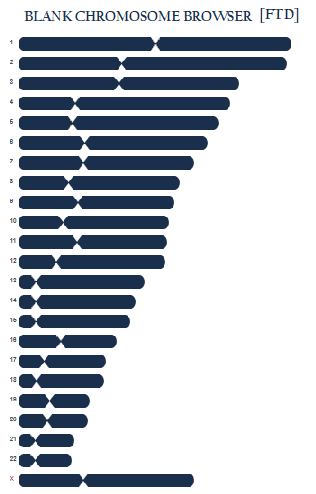To understand this more, you need to first visualise that every person is made up of 23 chromosome pairs AND that these chromosome pairs are represented as 23 bars/rods as is shown in the picture below.
Below is a closer view of a "blank" Chromosome Browser produced by FTD
Family Tree DNA Note that the Chromosome pairs are varied lengths, which is why they are different lengths in the browser. You will get accustomed to this in time.
An autosomal DNA test gives you results/matches for chromosome pairs 1 - 22.
If you are Female, an mtDNA test will give you results/matches on your 23rd Chromsome pair, shown in the image as x. If you are Male, a Y-Chromosome test will give you results/matches on your 23rd Chromosome pair, and instead of showing an 'x' - as in the picture above, it will instead have the letter 'y'.
For the purposes of this blog, and for mapping ancestors in a DNA context we are only concerned with an AUTOSOMAL DNA TEST RESULTS and therefore only the first 22 chromosome pairs.
Now, when you receive your test results [your match list of relatives] they have shared DNA at various chromosome placements. For those readers, that like me have had their DNA tested by Ancestry.com; you will not "see" which chromosome pairs who share with your DNA matches. Ancestry works it out for you and merely gives you an overall kinship estimate. Life would be so much easier if Ancestry.com provided a chromosome browser!
However, there is an option at Ancestry.com that allows you to download your RAW DATA. Once you have done this, you are able to UPLOAD it to sites on line that DO have a chromosome browser. Sites that I have used and have had success with are "Family Tree DNA" and "Gedmatch".
I use both sites, so I am able to easily ascertain the precise location of shared DNA with one of my matches. For example, David [surname removed] from Australia has shown up as a DNA match list in Family Tree DNA. He and I share 64 Centimorgans and therefore Family Tree DNA estimate that the relationship range between David and I is 2nd - 4th Cousin. However, I do not know David, nor do I know how he and I are related. David has a family tree attached to his results, I do not recognise any of the names in his family tree.
 |
| David is reckoned as being somewhere between a 2nd - 4th cousin based on 64cM of shared DNA. |
Furthermore, what these large companies don't tell you up front, is that the "Longest block" is what matters the most! The focus should be on the longest block shared; which is 22 centiMorgans long, rather than the figure of 64 centiMorgans. A kinship estimate based on an overall total can be flawed, particularly if that overall total consists of lots of small blocks of DNA.
This is particularly important when looking at shared DNA of Polynesians or other first nation peoples with small gene pools. I will cover this in more detail in another post [coming soon].
The longest block I share with David is 22 centiMorgans, so this would definitely mean 4th cousins as opposed to 2nd cousins. This will take some work to establish the connection but its still relatively close enough to work out if there are family genealogists on both sides willing to put in the effort. Thankfully there are - and I will be reporting on the progress with David as I go along.
Below, is what the shared DNA between David and I looks like on a Chromosome Browser. Our shared DNA sits on Chromosome 4 and Chromosome 12.
The Chromosome Browser will also give you more precise figures for location.
These figures may not mean much in isolation. However, over time other matches may land in this same area, particularly matches that you may actually know how you ARE related to already.
DNA is not a quick fix, unless you are lucky enough to stumble across close relatives. It still requires you to map out in your Chromosome pairs where particular DNA has been inherited from particular ancestors.
As it happens, I have begun to map out my Ancestors, and the position where David's shared DNA falls on Chromosome 12 seems to be DNA inherited from my REID side. There are already two other matches at that placement, who are related to me via that lineage - which is why REID is recorded next to their name. Everyone at this placement is related to each other, whether we know how or not. David is my relative, as well as being Carew's relative and Tracey's relative. At the time of writing this post, I am about to make contact with Lynette, David's sister; to see if Newfoundland and Canada mean anything to her in terms of her Family Tree. Watch this space for updates.
In the next blog post, I will be talking about how you can store the information of your matches on a DNA painter. At the same time I will be working on a post explaining the necessary approach when dealing with Polynesian DNA.
Please ask questions in the comments box below, if you found this post difficult to understand.
Mauri ora! [Bless you!]







No comments:
Post a Comment